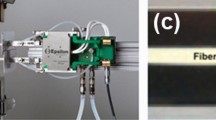Abstract
In holographic interferometry with a photoelastic model, two families of fringes are generated simultaneously when the model is stressed. One family represents the isochromatic-fringe pattern normally associated with photoelasticity which yields the difference between the principal stresses. The other family represents the isopachic-fringe pattern associated with interferometry which yields the sum of the principal stresses. From these complementary patterns, the magnitudes of the principal stresses can readily be determined throughout the field of observation. Unfortunately, these fringe patterns are not completely independent but interact in such a way as to make interpretation difficult in critical regions of the model. A new system has been developed which readily permits simultaneous acquisition of these fringe patterns without their undesirable mutual interaction, as well as providing increased sensitivity.
This new interferometer uses a double-pass object beam and an optical rotator to eliminate the isochromatic-fringe pattern and its effect from the isopachic interferogram. Such a system has considerable value in experimental mechanics for applications to both static and dynamic model studies and to materials investigation.
Similar content being viewed by others
Abbreviations
- A :
-
position of collimating lens
- A 1,A 2 :
-
components of the complex amplitudes of the light in the directions of σ1 and σ2
- A R :
-
complex amplitude of the reconstructed light wave
- \(A_{T_1 } , A_{T_2 }\) :
-
total-complex-amplitude components
- B, ΔB :
-
focal point of lenses and lateral displacement of the focal point, respectively
- C 1,C 2 :
-
stress-optic coefficients
- FL :
-
focal length
- H :
-
magnetic-field intensity
- I :
-
light intensity
- M :
-
maximum image-specimen misalignment
- N,N ∞ :
-
local and remote fringe counts, respectively
- V :
-
Verdet constant
- a :
-
radius of hole in specimen
- a 0 :
-
magnitude of the light vector
- k :
-
wave number 2π/λ
- t, t 0 :
-
thickness of loaded and unloaded specimen, respectively
- n 0 :
-
index of refraction of unstressed material
- n 1,n 2 :
-
indices of refraction of stressed material associated with directions of σ1 and σ2
- r, θ:
-
polar coordinates
- x, y :
-
rectangular coordinates
- λ:
-
wavelength of light
- ϕ:
-
phase of wavefront
- δφ1, δφ2 :
-
change of phase associated with σ1 and σ2
- σ:
-
remote tensile stress
- σ1, σ2 :
-
principal stresses
- θS :
-
rotation angle of polarization ellipse
References
Favre, H., “Sur une Nouvelle Méthode Optique de Determination des Tensions Interieures,”Rev. d'Optique,8,193–213,241–261, 289–307 (1929).
Post, D., “Photoelastic Evaluation of Individual Principal Stresses by Large Field Absolute Retardation Measurements,”Proc. SESA, XIII, (2),119–132 (1956).
Nisida, M. andSaito, H., “A New Interferometric Method of Two-dimensional Stress Analysis,” EXPERIMENTAL MECHANICS,4, (12),366–376 (Dec. 1964).
Fourney, M. E., “Application of Holography to Photoelasticity,” EXPERIMENTAL MECHANICS,8, (1),33–38 (Jan. 1968).
Hovanesian, J. D., Brcic, V. andPowell, R. L., “A New Experimental Stress—Optic Method: Stress-Holo-Interferometry,”Experimental Mechanics,8, (8),362–368 (Aug. 1968).
Fourney, M. E. andMate, K. V., “Further Application of Holography to Photoelasticity,” EXPERIMENTAL MECHANICS,10, (5),177–186 (May 1970).
Hetenyi, M., Handbook of Experimental Stress Analysis, John Wiley and Sons, New York (1950).
Sanford, R. J. andDurelli, A. J., “Interpretation of Fringes in Stress-Holo-Interferometry,” EXPERIMENTAL MECHANICS,11 (4),161–166 (April 1971).
Bubb, F. W., “A Complete Photoelastic Instrument,”Inl. Opt. Soc. Am. 30,297–298 (1940).
Freiser, M. J., “A Survey of Magnetooptic Effects,”IEEE Trans. on Magnetics 4, (2),152–161 (1968).
Dudderar, T. D. andO'Regan, R., “Measurement of the Strain Field Near a Crack Tip in Polymethylmethacrylate by Holographic Interferometry,” EXPERIMENTAL MECHANICS,11, (2),49–56 (Feb. 1971).
Howland, R. D. J., “On the Stresses in the Neighborhood of a Circular Hole in a Strip Under Tension,”Trans. Roy. Soc. London,229,Series A,49–86 (1930).
Author information
Authors and Affiliations
Rights and permissions
About this article
Cite this article
O'Regan, R., Dudderar, T.D. A new holographic interferometer for stress analysis. Experimental Mechanics 11, 241–247 (1971). https://doi.org/10.1007/BF02329034
Issue Date:
DOI: https://doi.org/10.1007/BF02329034




